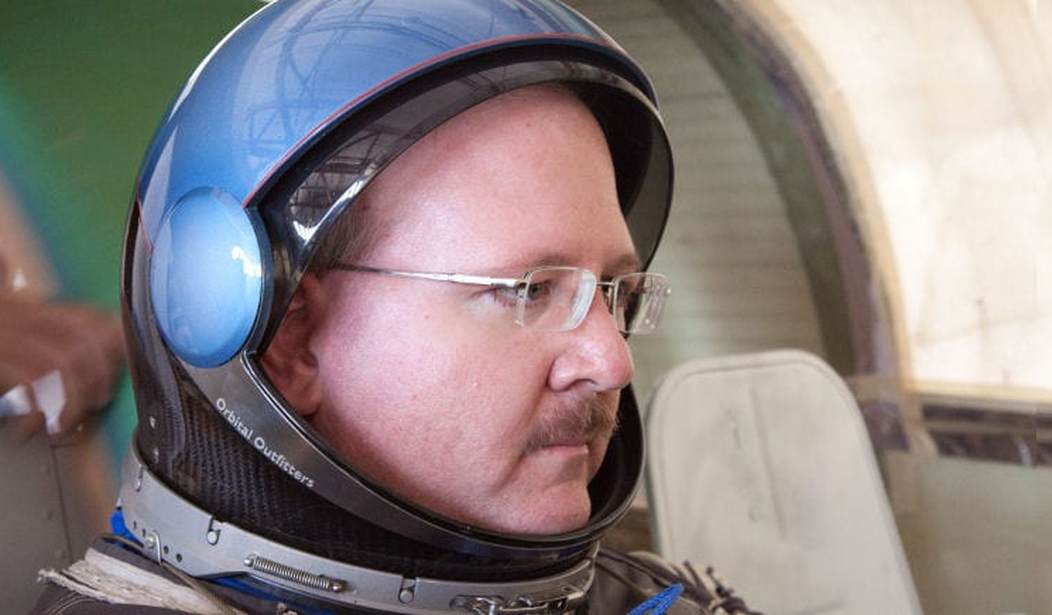I’ve known Jeff Greason for years, and we might or might not be plotting to take the sun hostage every night for some hours and not let you have it back until the morning unless you pay us one billion dollars.
Okay, that’s the joke, but Jeff and I share one very strong influence in the works of Robert A. Heinlein, which molded our juvenile minds in dramatically different, but in the end complementary, ways.
Both of us are, needless to say, interested in space. This might be true or not of all Children of Heinlein™, but in our case, it guaranteed we’d eventually run into each other.
Our most recent moment of “running into each other” happened at the Tennessee Valley Interstellar Workshop in Huntsville, Alabama, last month. I was there in my own interest, as a science fiction author (and I brought home a notebook of ideas mostly for short stories) and at the encouragement of my editor at PJ Media to cover the event, the people, and the technological ideas for the site.
Jeff Greason was there in his role as chairman of the board of Tau Zero.
While I’ve already written an article about the conference (and I should warn you there is another on the way. Everything was delayed by an attack of the common cold due to the fact the hotel was excessively air conditioned), it occurs to me that I can explain things from the point of view of the layperson, but not the point of view of a technician thoroughly immersed in the field and in what is and isn’t within the realm of current technology. Hence a two-part interview with Jeff, on his perspective on the field right now and the reasons for his interest in interstellar travel.
So, to begin with:
Jeff, unlike a lot of us who are determined to go to space for various reasons, including that freedom thrives on frontiers, you actually have the technical background to help us get there. To those who never heard of you, please give a summary of your qualifications.
Oh, I’ve had a rather varied career. Grew up on Star Trek and Robert A. Heinlein, in the immediate aftermath of Apollo, thinking the space frontier would be open before the year 2000. I always liked circuits and electronics, and I thought that there’d be plenty of jobs in the space field for that skill, so that’s what I studied. I was one of the many students who was inspired by Richard Feynman while at Caltech, and when Challenger was lost and he was one of those who uncovered the flawed NASA culture behind it, I really lost faith that NASA would be the means by which the frontier would be opened. They’ve done great work in robotic exploration, but that was the moment when I really started to realize that exploration and economic use and settlement are different things that take different tools and organizations. I then went to Intel and worked on chip-making technologies; recently someone told me that some of the tricks from my time there, much further developed now, are still in use.
In 1992, the DC-X started to come together: a reusable rocketship, developed for the unheard of sum of $120 million, that was flown by a crew of dozens, not thousands. I met my congressional representatives for the first time, asking for them not to cancel that program when strategic missile defense started to lose political favor. In 1994 I went to a conference, Space Access, in Phoenix, where I got exposed to a simple, but powerful idea – that if we want to go to space, we don’t have to lobby the government to fund a program, what we need is to find a market, raise money, and build a space transportation product or service. I came out transformed, saying “that is what I want to work on.” So I decided to find a company to work with. I joined AIAA, the professional association for aerospace engineers, ordered most of the books in their catalog and read them, drove down to the library on weekends and read every issue of the Journal of Spacecraft and Rockets and every issue of the Journal of Propulsion and Power from volume 1, issue 1 to the present, and started working on evenings and weekends on how to make a business from space transportation
In 1996 I presented a paper at Space Access on how different rocket propellants influenced the cost of operations of a rocket vehicle – everyone used to talk about performance, not about cost. Gary Hudson noticed that and in 1997 asked me to join his company, Rotary Rocket. He wanted someone who understood not only the technology of aerospace but the project management approaches of commercial technology industries. I took the job, and for two years I led a team that essentially had to re-invent the discipline of how you do rocket engine development. It was a bit of a lost art at the time; the people who had done it last were long retired. But after two years, the company ran out of money and we all got laid off. The core of the propulsion team did not want to give up, and they essentially drafted me to be the CEO of a new company to try again; that became XCOR Aerospace.
XCOR did some really groundbreaking work on reusable rocket engines; I’m not sure even in the industry the full extent of that is known. We essentially developed liquid rocket engines that did not wear out – at least not in the first few thousand firings. We had one go two thousand or so firings and it looked essentially brand new. The only maintenance between flights was a quick visual inspection with a flashlight. I’ve been told as recently as two years ago that such a thing is impossible – well, it isn’t impossible, we did it. We converted an airplane to use that rocket propulsion, and flew it with a crew of four plus the pilot – by the end of its life, we had the cost per flight down to $900, which I think is pretty respectable for a manned rocketship, however modest. We then had a client who wanted something a bit more ambitious for an entertainment application; for that, they wanted a very short turnaround time. On that program, we got to the point where, with a sort of NASCAR-like ground crew, we could pull the rocket in, put the chocks in, service it, and reload with propellant in just under ten minutes. Between those two vehicles, we had 66 rocket flights, with crew aboard, without ever losing anyone. I think we really pushed the state of the practice on how to run those operations with a high degree of professionalism and excellent safety discipline, while simultaneously keeping the very small team and very low operations cost that commercial success will require.
Along the way, I had been putting together ideas on how the regulatory regime for commercial human spaceflight should work and had been working with the Office of Commercial Space Transportation about that topic. That eventually came to the notice of Congressman [Dana] Rohrabacher and others, and I and a few others expanded those thoughts, which eventually became the Commercial Space Launch Amendments Act of 2004 and is still basically the regulatory framework we have today.
I served in the Augustine Commission to try to develop credible alternatives for how NASA could do manned space exploration within their budget, which was an incredible learning experience. Unfortunately, there are some constraints, not so much on what NASA could do, but on what they will likely be allowed to do, or funded to do, which make that a very tough problem. NASA can be and should be an essential part of the national space enterprise, both as part of a national grand strategy and as a technology engine to provide breakthrough capabilities to industry. Doing those roles well requires constantly reassessing where the U.S. industrial base is today, what things the private sector can do and what things make sense to keep as a government-provided capability.
The vehicle XCOR was developing for revenue service, the Lynx, required us to again resurrect a lot of lost art, like “how do you make a supersonic vehicle that flies out of the atmosphere and back and can be flown by a human being?” That wound up taking a long time to develop, which meant more money, which meant new investors. Eventually, they wanted a new CEO, and shortly thereafter, I no longer had resources or responsibilities. After about six months of that, I left.
Currently I’m involved in three main things: Agile Aero, a company to take lessons learned on vehicle development and pioneer ways to prototype supersonic and hypersonic aircraft or space vehicles quickly and cheaply; Electric Sky, which is a company developing some very out-of-the-box ideas on how to do vehicles which are powered from the ground, both for space launch and for high speed flight between places on Earth; and the Tau Zero Foundation.
Would you give us a quick introduction to Tau Zero — what it is, what it aims to do, and how it goes about accomplishing those aims?
Our mission statement calls for us to gather the scientists and engineers it will take to develop the technologies for human flight to other star systems with a trip time less than a human lifetime. While generation ships are an interesting concept, I think it makes more sense to work on the technologies for faster flight, because even for robotic missions, getting a mission funded that would not return science data within the lifetime of the initial investigators is going to be challenging.
Once you can see how to reach another star, even a robotic mission, in 20 or even 40 years from launch to data return, there will probably be missions flown. Right away, when confronting that problem, you find that the collection, transmission, storage, and use of very large amounts of energy are topics that keep coming up – those are technologies with a lot of nearer-term uses as well, and they’re the technologies that also enable advanced propulsion within the solar system.
Most of our emphasis is on technology that works with the physics we know. We do have people with a background in breakthrough propulsion physics and we have some things we are watching there, but I think the important message is that there really are ways, within the physics we know, that look tractable for interstellar flight. Of course, it is a very difficult problem, which is what makes it interesting – making ten percent improvements doesn’t touch the core challenges; we need technologies that improve how much energy we can apply, or how much energy it will take, by orders of magnitude.
In day to day terms, that really consists of an ongoing conversation with subject matter experts, looking for “missing link” technologies, where if only we had this one piece demonstrated, it would show that a larger breakthrough is now possible, which might attract more investment and more smart people to work on it, and so on.
One example is antimatter – a lot of people have talked about it, about how it is currently difficult or expensive to produce. We found that there really were good ideas for how to produce it better, but they’d take significant investment. But no one makes that investment, in part because there’s no good way to store it in ways that are light enough to be useful. So we’ve researched and chosen two candidate ideas for antimatter storage technologies which can show key demonstrations for hundreds of thousands of dollars and we’re seeking that funding.
Another is high thrust to weight magnetic sails. We are moving forward to develop a concept that NASA funded, which showed real promise but was abandoned. For interstellar missions, that’s incredibly useful because it gives a way to stop at the end, which makes the mission much easier. And it has nearer-term applications – like cutting trip time to Mars from months to weeks, simply by using the energy that is already there, in the stream of particles flowing out from the Sun that are accelerated by the Sun’s magnetic field. And since that same solar wind is potentially an energy source we can tap to provide vast quantities of affordable power to the Earth, learning to use that has near-term implications. So I’m developing a minimum cost demonstration mission for that technology, and we are seeking sponsors.
My role is primarily advising on direction and helping to identify technologies of interest. Rhonda Stevenson runs the Foundation and there’s a lot of other subject matter experts, and Andy Aldrin is with me on the board.
[Part Two follows tomorrow.]









Join the conversation as a VIP Member